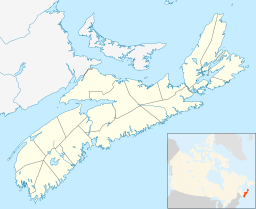Kidston Lake facts for kids
Quick facts for kids Kidston Lake |
|
|---|---|
| Location | Halifax Regional Municipality, Nova Scotia |
| Coordinates | 44°35′45″N 63°37′12″W / 44.59583°N 63.62000°W |
| Type | acidic glacial lake with somewhat limited fauna |
| Primary inflows | small stream at southern end and springs |
| Primary outflows | stream at northern end which feeds into the Macintosh Runs which empties into the Atlantic Ocean at Herring Cove |
| Basin countries | Canada |
| Max. length | 630 m (2,070 ft) |
| Max. width | ~ 50 to 300 m (160 to 980 ft) |
| Average depth | up to 20 feet (6.1 m). South end shallow. Muddy bottom. |
| Shore length1 | rocky in most places, with an artificial beach on the east side. Where there is no rock, the forest grows to the shoreline. |
| Islands | one flat rock called the Whale's Back, about 5 square metres (54 sq ft) |
| Settlements | about 9 km (5.6 mi) from downtown Halifax |
| 1 Shore length is not a well-defined measure. | |
Kidston Lake is a beautiful lake found in the Spryfield area of Halifax Regional Municipality, Nova Scotia, Canada. It's a favorite place for swimming, especially during the summer. The eastern side of the lake has a park with sandy beaches and lifeguards.
You can find many trails around the lake. These trails lead to places like Leblin Park and other neighborhoods. South of the lake, there are rocky areas where you can find lots of blueberries. Foxes and porcupines also enjoy these berries!
One of the most famous spots at the lake is the Rocking Stone. This huge boulder weighs over 90 tons! It's a glacial erratic, meaning it was moved there by a glacier long ago. You can still make it rock a little with a lever. It used to move much more easily. But in the 1890s, some sailors made it more stable. Later, in the 1980s and 90s, too much rocking wore down its base.
Another cool rock is Table Rock. It's a large, flat granite rock weighing about 30 tons. It sits perfectly balanced on three smaller rocks. You can find it northwest of the narrow part of the lake, where the water flows out.
History of Kidston Lake
The area around Kidston Lake has been used for logging many times, especially in the 1900s. Until about 1963, there was a small logging business and a mill right on the lake. This left a big pile of sawdust.
The Rocking Stone was a very popular picnic spot in Victorian times. People would travel from Halifax to sit on it and enjoy their lunch while gently rocking.
Today, the eastern shore of Kidston Lake is a popular swimming spot in the Spryfield area. It was turned into a city park with a man-made sandy beach. New houses have been built nearby, and more development might happen on the western side of the lake.
Lake Environment: Geology, Biology, and Water
Kidston Lake sits on top of granite rock that formed a very long time ago. This granite is part of a larger rock formation in Nova Scotia. The soil around the lake is thin and a bit acidic. This type of soil supports forests with trees like spruce, fir, maple, and birch. You'll also find many bogs and rocky areas.
The lake gets most of its water from underground springs and a small stream at its south end. Water flows out of the lake at its north end into another stream. The south end of the lake is quite shallow and has many plants. The middle part of the lake is deeper, up to 20 feet, which is great for swimming.
An earthen dam at the north end helps keep the water level high. Loggers built this dam in the early 1900s. For a while, fine sawdust from logging polluted the lake's water. This reduced the amount of wildlife. But since the 1990s, the water has cleared up. Now, you can find fish, many frogs, and different kinds of water bugs there.
The lake's water is naturally a bit acidic. This is because the land around it has many bogs and granite rocks. Beavers sometimes live on the lake. In 2011, there was an active beaver lodge on the northwest shore of the lake.


